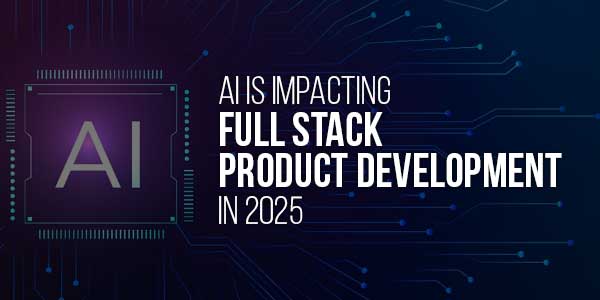
Imagine a small startup founder with no engineering team, yet shipping a web app in weeks. In early 2025, a UK product designer did just that – she built a full B2B SaaS (with login, database, payments, and alerts) in under two weeks entirely with AI assistance. This isn’t sci-fi: AI has become an everyday coding companion. According to a recent report, generative AI can let developers complete coding tasks up to twice as fast, and most developers (76%) now use or plan to use AI tools in their workflow.
For businesses aiming to build and launch scalable web apps efficiently, Full Stack Development Services remain essential. These services combine frontend and backend expertise to deliver complete, production-ready solutions—now enhanced with AI for even faster results.
One of the 2024 industry survey notes that AI tools are “already deeply embedded in the daily work of professionals, from programmers to healthcare providers”. In short, AI is rewriting how software gets built: automating routine tasks and turbocharging creativity.
Table of Contents
AI On The Frontend: From Sketch To Screen:
On the frontend, AI is like a design assistant and code co-pilot. You can hand an AI a simple prompt or design mockup and get back HTML/CSS/JS code that works. For example, tools like Builder.io’s Visual Copilot or Figma plugins can convert designs to React, Vue, or Flutter code in one click. AI assistants also help write UI code. GitHub Copilot (an AI pair programmer) can autocomplete HTML or CSS from comments, and Replit’s Ghostwriter can “automagically complete the code you’re working on”. Ghostwriter even offers an “Explain Code” feature that gives a plain-English summary of your code. These features let designers and non-experts generate polished UI components without writing every line by hand.
AI also boosts front-end testing and debugging. Platforms like LambdaTest use AI to generate and run UI tests at scale. One report claims LambdaTest’s AI-accelerated testing runs up to 70% faster than traditional cloud test grids. Meanwhile, Copilot or similar tools can suggest fixes for JavaScript errors or even automatically find and patch common bugs during pull requests. Vercel’s ecosystem is another example: in 2024, Vercel launched new AI integrations that let developers add chatbots, smart search, and other AI services to a website with a few clicks. In sum, AI can generate a complete front-end prototype from a description, then test and refine it automatically, letting teams iterate on UI faster and more confidently.
AI On The Backend: Smarter Servers And APIs:
In the backend, AI writes much of the boilerplate code that used to take days. Need a REST API or database migration? You can ask an AI assistant to generate it. For example, based on your comments, GitHub Copilot will “suggest lines or whole blocks of code” for server routes or database queries. Replit’s online IDE also has a built-in AI helper (Ghostwriter) that can create cloud functions or SQL queries from prompts so that you can go from idea to working code in minutes. Some platforms, like Bolt.new (by StackBlitz), even let you describe an entire app in chat and handle setup, from Node.js backend to React frontend, all in-browser. And tools like Lovable can take a natural-language specification (“a task tracker with user login and Stripe billing”) and spit out a complete web app with authentication, database tables, and payment integration.
These AI tools also help with databases and services. Imagine telling AI, “generate a MongoDB schema for a blog post and an API endpoint to query posts”. The AI will write the JSON schema and server code for you. It can integrate third-party services, too: in one real case, a founder used AI to set up Stripe payment webhooks and email alert functions without writing a single line manually. In short, AI can bootstrap full backend systems (servers, functions, databases) from high-level prompts.
AI In DevOps: Automation And Monitoring
On the DevOps side, AI is streamlining testing, deployments, and monitoring. Continuous Integration/Deployment pipelines can be AI-enhanced – for example, GitHub Copilot now even suggests YAML for GitHub Actions and can automate release workflows. Copilot’s makers note it “enhances aspects of CI/CD workflows” and indirectly cuts developer effort. Testing pipelines use AI to prioritise and fix failures: tools like LambdaTest use AI to identify flaky tests and suggest fixes. Containerization and cloud infrastructure can also be AI-assisted: you might describe your deployment needs and let AI generate Kubernetes configs or Terraform scripts.
Cloud platforms themselves are embedding AI. Vercel’s 2024 updates added an “AI marketplace” where you can plug in pretrained models (for search, translations, Q&A, etc.) into your web app instantly. Similarly, services like AWS CodeWhisperer generate AWS-focused backend code and security checks automatically. On the monitoring side, AI-driven tools can analyse logs and performance metrics for anomalies faster than humans. In practice, this means developers spend less time on repetitive DevOps chores and more on improving service quality and new features.

Key AI Tools of 2025:
Developers today use a wide array of AI-powered tools. Some big names include:
- GitHub Copilot – An AI pair-programmer that suggests code in your IDE (VS Code, etc.), completing functions or classes based on context. It works for frontend, backend, and even DevOps scripts.
- OpenAI ChatGPT – A general AI chatbot that can answer coding questions, generate snippets in dozens of languages, and even help with documentation or system design. (A 2024 survey found ChatGPT to be the most-used AI tool among devs, with 74% planning to keep using it.)
- Replit Ghostwriter – An in-browser AI assistant integrated into the Replit IDE. It can autocomplete code, explain code in plain English, and transform code (e.g. refactor loops to recursion). Replit also offers “Replit AI” projects to go from prompt to hosted app in minutes.
- Vercel AI (v3.0 SDK) – Vercel’s AI toolkit for Next.js and React apps. With this SDK, front-end UIs can call AI models (text, images, etc.) as easily as database queries. One analysis showed using Vercel’s AI SDK can automate repetitive UI tasks and boost developer productivity by up to 50%.
- LambdaTest / KaneAI – AI-driven testing platforms. LambdaTest’s AI-powered execution (called HyperExecute) claims test runs 70% faster than traditional grids, and its “KaneAI” agent can create and debug tests from plain English.
- Cursor – A newer AI-first code editor (based on VS Code) that lets you chat with your codebase. You can ask it to refactor across files or explain complicated logic. Developers often describe it as moving from “assistant” to “active collaborator”.
- new – A StackBlitz project that lets you “prompt, run, edit, and deploy” full-stack apps entirely in the browser. You simply tell it what app you want, and it sets up the framework, backend, and frontend for you.
- dev – A no-code/low-code AI platform. You describe the app in chat and Lovable generates the front end, back end (often using Supabase), and even connects services like Stripe. It’s designed for founders who want a working prototype without writing code themselves.
- Cursor & Windsurf – Cutting-edge “AI IDE” projects. For example, Windsurf’s “Cascade” agent can scan an entire codebase and perform multi-step edits (like migrating an API across services) autonomously. Cursor’s integrations (even with Figma) aim to eliminate manual design-to-code tasks.
- Generative UI tools – Many plugins and apps transform design files into code. For instance, Builder.io’s “Visual Copilot” can convert Figma designs to React, Vue, Flutter or even plain HTML/CSS with one click (supporting Tailwind, Svelte, Angular, etc.). These help teams rapidly iterate UI prototypes.
(Aside: This is not an exhaustive list – new AI dev tools emerge monthly. But the trend is clear: there are AI helpers for almost every part of development.)
Teams, Speed, And Collaboration In The AI Era:
With these tools, the developer’s role is evolving. AI is not replacing programmers, but acting as a tireless teammate. According to a LeadDev report, experts now expect developers to “engage in a conversation with their platforms” and leverage AI suggestions routinely. As one AI champion put it, future teams will “start projects a lot faster, accomplish much more in less time, and overcome barriers that previously caused projects to stall”. A 2023 McKinsey study echoes this: developers using generative AI shaved their coding time in half on many tasks.
Roles shift: Junior coders or designers can now do more, while senior engineers spend time reviewing AI output and defining architecture. In many teams, one person might focus on writing effective prompts (“prompt engineering”) while another integrates the results. Collaboration can also improve – AI-generated draft pull requests or documentation give team members a head start. Despite the power of AI, surveys show developers aren’t panicking about job loss: 70% of devs say AI is not a threat to their job, and many see it as a helpful colleague. As OutSystems VP Joe Ghattas notes, “Fears around AI taking developers’ jobs will fade away and AI will be seen as a colleague who deserves trust, but also requires robust control”. In practice, this means humans remain in the loop: AI handles routine code, but people drive the creative, high-stakes decisions.
Ultimately, teams are shipping faster. For example, recall the solo founder story above: with AI tools, she went from zero code to a live web service in weeks. Larger teams see similar gains. One industry analysis found that GenAI is already boosting productivity for programmers (enterprise spending on AI tools jumped 6× to $13.8B in 2024). StackOverflow’s 2024 survey confirms this zeitgeist: most developers (76%) are integrating AI into their dev process, especially for writing and testing code. In short, AI is giving teams superpowers – they can try ideas, write code, and fix bugs faster than ever, as long as they coordinate and review each other’s AI-aided work.
Cautions: Bugs, Debt, and Ethics:
Despite the hype, there are downsides to watching. AI can make mistakes that humans wouldn’t. Research shows that code generated by AI often has unique bugs and security issues. For instance, a recent study found developers using AI assistants are more likely to introduce security vulnerabilities than those coding by hand, because the AI code looks plausible but can hide flaws. AI-generated code is also more prone to duplication and technical debt. In one report, AI-powered development led to an 8× increase in duplicated code blocks (violating the “don’t repeat yourself” principle). An industry veteran remarked, “I don’t think I have ever seen so much technical debt being created in such a short period,” thanks to AI codegen. This means teams must budget extra time for code review and refactoring and avoid mindlessly pasting AI output.
Quality assurance becomes critical. AI doesn’t automatically test or debug – it often omits corner cases or produces incomplete logic. Developers must carefully review and test AI-written code. Over-reliance is dangerous: treating the AI as infallible can let bugs slip into production. Additionally, ethical issues arise. In StackOverflow’s 2024 survey, 79% of developers were worried about misinformation or disinformation in AI results, and 65% were concerned about source attribution. Indeed, since models are trained on public code, there are open questions about licensing and plagiarism (for example, inadvertently replicating GPL code).
In short, AI is a powerful tool but still requires human oversight. Teams should use it to assist – to draft code, generate tests, even refactor – but not blindly ship AI output. Good practices include: writing clear tests, code reviews focused on AI-written sections, and treating AI comments with scepticism. As one LeadDev article warns, AI will “underperform” at times and can be “lazy,” so it’s up to engineers to catch where it goes wrong.
The New Reality of Development:
By 2025, the typical development workflow will be more “AI-assisted” than ever. Developers and AI agents work side-by-side: AI handles the grunt work of coding, testing, and deployments, while humans plan, integrate, and ensure quality. Many in the industry compare this to having a tireless helper or a search engine that understands your code. But unlike a tool, AI suggests entire solutions – it’s like having a junior engineer who never sleeps.
The bottom line: AI is radically transforming full-stack development. Speed and productivity are up; team roles are shifting toward design, architecture, and oversight. Tools abound, from Copilot and Ghostwriter to AI-driven CI/CD pipelines. Real-world success stories are multiplying, from one-person startups to enterprise projects. Yet caution is needed: AI isn’t perfect. Developers still need to validate, secure, and refine whatever the AI generates. When used wisely, AI becomes a superpower: it frees us from tedium and unlocks creativity. But like any powerful tool, it demands responsibility. In the hands of developers who test, review, and guide it properly, AI is set to make 2025 one of the most exciting years ever for software creation.

 About the Author:
About the Author:
















Be the first to write a comment.